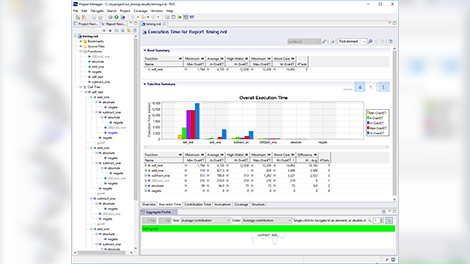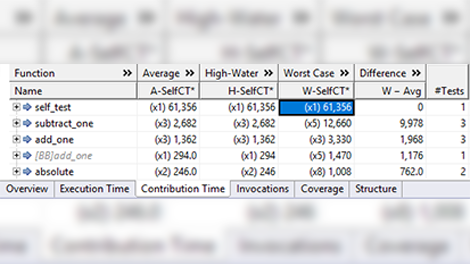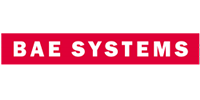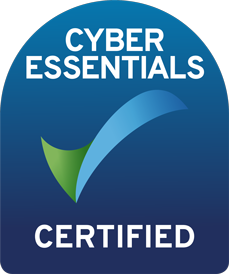
In-depth execution time analysis for critical software
Why choose RapiTime?
Timing analysis (inc. WCET) for Ada, C & C++ on-target & host
By automating code instrumentation and the collection of timing metrics on target, RapiTime reduces the effort needed to understand and verify your code’s timing behavior. Flexible integration strategies ensure efficient verification, regardless of your target hardware.
RapiTime’s hybrid worst-case execution time (WCET) calculation leverages the benefits of static analysis and measurement-based approaches to produce WCET results that represent behavior on the real system and provide a safe upper bound on WCET while minimizing pessimism.
Identify code to optimize for worst-case behavior
Optimizing code to improve average case performance often has little effect, and may even have a negative effect, on worst-case timing behavior.
RapiTime helps you identify the code elements that have the highest contribution to your system’s worst-case timing behavior. This helps you focus your optimization efforts on the sections of code that are most likely to affect your code’s worst-case behavior.
Debug rare timing events
During program execution, many events occur, and debugging the source of issues like rare timing events can be like searching for a needle in a haystack.
RapiTime helps you debug rare timing events in your code by letting you step through your program execution step by step as you would with a code debugger.
Simplify verification through integration with your continuous test tool
Keep your verification on track by using RapiTime alongside your continuous integration tool. Collect timing results and track your project’s progress over time with our plugins for Jenkins and Bamboo.
By analyzing your code with RapiTime on every new build, you can easily identify anomalies in execution time results as they happen.
Produce evidence for DO-178 and ISO 26262 certification
Get ready for DO-178C certification with our qualification kits. Our off-the-shelf qualification kits and qualified target integration service help you on the road to qualifying your use of RVS.
Many features of RVS are qualified, including our instrumentation, which has saved customers like Collins Aerospace a huge amount of manual effort.

Product features
-
Execution time analysis Analyze the execution time behavior of code as tested on the embedded hardware.Discover this feature
-
Worst-case execution time analysis Produce WCET metrics through a hybrid measurement-based/static analysis approach.Discover this feature
-
Response time analysis Analyze software response times.Discover this feature
-
Analyze timing behavior across code sequences Collect timing measurements between any points in code.Discover this feature
-
Investigate multicore interference effects RapiTime supports the investigation of multicore interference effects and plays a critical role in the MACH178 solution.Discover this feature
-
Optimize code for timing performance Easily identify code with the the greatest impact on timing performance.Discover this feature
-
Produce certification evidence Produce evidence for certification by following a recommended workflow that focuses analysis.Discover this feature
-
Capture values from hardware event monitors Capture and view values from hardware event monitors on your multicore platform.Discover this feature
-
Automatically merge timing results Merge timing data from different builds or test runs automatically.Discover this feature
-
Automate testing on host and target Run tests on host computers and test rigs in continuous build environments.Discover this feature
-
Analyze code complexity Analyze the complexity of your source code.Discover this feature
-
Efficient integration workflow Configure integrations of RVS into your development environment quickly and easily.Discover this feature
-
RVS Project Manager Take your test project from creation to completion with an intuitive user-interface.Discover this feature
-
Efficient, configurable analysis Apply instrumentation based on your functions' expected execution frequencies.Discover this feature
-
Shared integration with instrumentation-based RVS tools After integrating one RVS tool to work a development environment, it is trivial to use others.Discover this feature
-
Assurance issue notification We notify you of issues that may affect the validity of your results as soon as we identify them.Discover this feature
-
Redact source code for confidentiality Verification can be performed while source code is redacted to support verification by third-party suppliers.Discover this feature
-
Portable test environments Multiple users can share the same test environment.Discover this feature
-
Easily configurable analysis Apply analysis settings easily using a friendly user interface.Discover this feature
-
Compare reports Compare reports from different builds to track project progress over time.Discover this feature
-
Customizable workflow Customize the RVS workflow to best meet your needs.Discover this feature
-
Template integrations Create and use template integrations to reduce your effort integrating RVS with your system.Discover this feature
-
Customizable color scheme Customize the color scheme used to display your results.Discover this feature
-
Comprehensive verification toolsuite One tool to meet all your software verification needs.Discover this feature
-
Configurable export formats Export timing results in a variety of formats.Discover this feature
-
Timing analysis during unit testing Collect execution time metrics during unit testing to support timing optimization throughout the software life cycle.Discover this feature
-
View detailed timing metrics at a glance Specialized charts and tables make it easy to focus your analysis.Discover this feature
-
Analyze results from multicore timing analysis Capture and easily analyze results from tests for timing behavior in multicore software.Discover this feature
-
Code viewer View code with syntax highlighting and color-coding of results.Discover this feature
-
Rewind Trace Step through execution traces to investigate timing events using a debugger-like interface.Discover this feature
-
Execution Time Profile Chart View a histogram of your software's timing behavior to easily identify patterns.Discover this feature
-
Invocation Timeline Chart A timeline of your invocations helps you visualize the order of calls and how long each took to execute.Discover this feature
-
Aggregate Profile Chart A configurable chart helps you visualize timing data in the context of your code's call tree.Discover this feature
-
Easily filter results Easily filter results to focus your analysis.Discover this feature
-
Visualize call dependencies Visualize the call dependencies in your code.Discover this feature
-
View trends over time Follow verification results over time in CI servers and beyond.Discover this feature
-
Advanced search function Search reports for specific elements using advanced queries.Discover this feature
-
Treemaps View coverage and hierarchy of code at a glance.Discover this feature
-
Integrate with existing build systems Collect data from almost any build system.Discover this feature
-
Compiler wrappers The recommended build integration strategy requires little if any change to the development environment.Discover this feature
-
Clone integration Copy the build system to build and test code with RVS.Discover this feature
-
Multicore support Verify critical multicore systems.Discover this feature
-
Low target overheads Fit more tests on your target and reduce the number of builds you need to run.Discover this feature
-
Flexible integration strategies Collect data from almost any embedded target with flexible collection strategies.Discover this feature
-
iSYSTEM debugger Collect verification data from iSYSTEM debuggers.Discover this feature
-
Lauterbach debugger Collect verification data from Lauterbach debuggers.Discover this feature
-
MATLAB® Simulink® RVS can enhance PIL and HIL testing in Simulink® model-based development workflowsDiscover this feature
-
ANSYS® SCADE® Test your SCADE® models on-host and on-target through all phases of the verification lifecycle.Discover this feature
-
Jenkins Run RVS automatically through Jenkins to collect and archive results.Discover this feature
-
Bamboo Run RVS automatically through Bamboo to collect and archive results.Discover this feature
-
Deos Out-of-the-box integration with DDCI-I's Deos operating system.Discover this feature
-
Software Configuration Management Integration with Software Configuration Management tools ensures that files can be used across a team.Discover this feature
-
C Support for verification of code written in C.Discover this feature
-
C++ Support for verification of C++ code.Discover this feature
-
Ada Support for verification of code written in Ada.Discover this feature
-
Mixed language support Support for verification of code written in multiple languages.Discover this feature
-
Assembly Support for verification of Assembly code.Discover this feature
-
Compiler extension editor Manage extensions to support non-standard programming languages with an interactive editor.Discover this feature
-
Flexible licensing options Select floating or node-locked licenses with annual or perpetual duration.Discover this feature
-
Floating licenses Floating licenses support multiple users and shared working environments.Discover this feature
-
Node-locked licenses Node-locked licenses support the use of RVS on a single machine.Discover this feature
-
Perpetual licenses License RVS for use indefinitely.Discover this feature
-
Annual licenses License RVS in annual increments.Discover this feature
-
Easy to get started Integration and learning resources help you get started verifying your code in no time.Discover this feature
-
Support Dedicated support service to resolve technical issues quickly.Discover this feature
-
Tutorials Learn how to get the most from our verification solutions with simple, interactive tutorials.Discover this feature
-
Examples and sandbox projects Examples and sandbox projects help you get started quickly.Discover this feature
-
Training Get up to speed with custom training courses delivered by expert engineers.Discover this feature
-
Documentation Learn how to use RVS features with comprehensive documentation in both printed and electronic formats.Discover this feature
-
Help search Search the help system to find the most relevant resources quickly.Discover this feature
-
Easily migrate to new versions Easily migrate to new RVS versions with guided migration help.Discover this feature
-
DO-178B/C qualification kit Qualification kits for RVS qualification in DO-178B/C projects.Discover this feature
-
DO-278A qualification kit Qualification kits for RVS qualification in DO-278A projects.Discover this feature
-
Qualified Target Integration Service Additional evidence to qualify the use of RVS in your development environment.Discover this feature
-
Qualified instrumenters Qualified instrumentation that doesn't require manual review.Discover this feature
Downloads
News & Blog
Operating Systems
|
Type |
Operating System |
|---|---|
|
On-target deployment |
RVS tools can be used to analyze software run on any host operating system or embedded target (as long as a communication channel is available). |
|
On-host tool |
Windows 10 and 11 |
|
Windows Server 2019+ |
|
|
Variety of Linux distributions (including Ubuntu and Red Hat) |
|
|
For older operating systems, contact us. |
|
|
RVS tools can be qualified for use on all supported platforms. |
Programming languages
|
Language |
|---|
|
Ada |
|
C |
|
C++ |
|
Mixed languages |
Compilers
RVS is designed to be independent of the target compiler. We have already deployed with the compilers in the list below and can quickly add new compilers as required by our customers.
|
Vendor |
Compiler |
|---|---|
|
AdaCore |
GNAT GPL |
|
GNAT Pro |
|
|
Arm |
DS-5 |
|
armcl |
|
|
Borland |
Borland C++ |
|
Cosmic Software |
-- |
|
GNU |
GCC |
|
G++ |
|
|
Greenhills |
Ada MULTI |
|
C Multi |
|
|
IAR Systems |
Embedded Workbench |
|
Keil |
C51 |
|
Microsoft |
Visual Studio |
|
NXP |
CodeWarrior HCS12 |
|
TASKING |
CC166 |
|
Texas Instruments |
CL500 |
|
CL2000 |
|
|
Wind River |
Diab |
|
CCPPC |
RTOSs
RVS can be used on RTOSs used in the critical software industry. RVS has been used on RTOSs including the following:
|
RTOS |
|---|
|
AUTOSAR Adaptive Platform |
|
AdaCore Ravenscar Profile |
|
Blackberry QNX |
|
DDC-I Deos |
|
ERIKA Enterprise |
|
ESOL eMCOS - AUTOSAR Classic Platform & AUTOSAR Adaptive Platform |
|
FreeRTOS |
|
Green Hills Integrity |
|
Kronosafe Asterios |
|
LynxOS |
|
LynxSecure |
|
MaRTE OS |
|
MICROSAR - AUTOSAR Classic Platform |
|
MicroC/OS |
|
RTXC Quadros |
|
RI850V4 - micro ITRON v4.0 OS |
|
RTEMS |
|
SafeRTOS |
|
SYSGO PikeOS |
|
Vector MICROSAR |
|
Wind River Helix & VxWorks |
CPUs
RVS tools can be used to analyze software run on any host operating system or embedded target (as long as a communication channel is available). The following is a non-exhaustive list of CPUs we have worked with.
|
Vendor |
Platform |
|---|---|
|
Arm |
ARM7 |
|
ARM9 |
|
|
ARM10 |
|
|
ARM11 |
|
|
Cortex-M |
|
|
Cortex-R |
|
|
Cortex-A |
|
|
Analog Devices |
Blackfin |
|
SHARC |
|
|
SigmaDSP |
|
|
TigerSHARC |
|
|
ADSP-21xx |
|
|
Atmel |
AT90CAN128 |
|
Cobham Gaisler |
LEON3 |
|
LEON4 |
|
|
ESA |
LEON2 |
|
Freescale (NXP) |
68000 |
|
680x0 |
|
|
ColdFire |
|
|
M-CORE |
|
|
Power Architecture (MPC5xx, MPC55xx, MPC56xx, MPC57xx) |
|
|
ARM Cortex-M microcontrollers (Kinetis E series, Kinetis K series, Kinetis L series, Kinetis M series, Kinetis W series). |
|
|
56k DSP family |
|
|
QorIQ (P2010, P2020, P4080, P5010, P5020, P5021, P5040, T2080) |
|
|
IBM |
PowerPC (PPC) implementations: |
|
G1 (601) |
|
|
G2 (602, 603, 604, 620) |
|
|
G3 (740/750) |
|
|
7xx/750 family |
|
|
G5/970 series |
|
|
401 |
|
|
403 |
|
|
405 |
|
|
440 range |
|
|
Infineon |
|
|
XE166 family |
|
|
XC 2000 family |
|
|
C166 family |
|
|
TriCore |
|
|
Tricore Aurix |
|
|
Tricore Aurix Gen2 |
|
|
XMC1000 |
|
|
Texas Instruments |
TMS320C6x family |
|
TMS320C28x family |
|
|
TMS320F28x family |
|
|
TMS570 family |
Frequently asked questions
-
How do I learn more about RapiTime?
You can request a trial version of RVS, which includes RapiTime. You can also arrange a demonstration, where a member of our team will work with you to show the benefits RapiTime can offer you.
If you're interested in RapiTime in academia, you can search for it in the academic press.
-
What is RapiTime?
RapiTime is the leading tool for worst-case execution time analysis of critical software.
Used globally in the aerospace and automotive industries, it reduces the cost of analyzing the worst-case timing behavior of critical software.
As part of the RVS toolsuite, it forms part of a software verification solution that also includes tools for functional testing and structural coverage analysis.
-
How does RapiTime work?
RapiTime works by injecting instrumentation code into source code and executing the native build system so that timing results are collected during program execution. Data can be collected from almost any target hardware by a variety of approaches.
-
Which host operating systems can RVS be used on?
RVS tools can be run on the following x86-64 operating systems:
- Windows 10 and 11
- Windows Server 2019+
- Variety of Linux distributions (including Ubuntu and Red Hat)
RVS tools can be used on projects with unsupported operating systems by using a clone integration to split the process and delegate parts of it to the unsupported machine.
-
Which hardware architectures do RVS tools support?
RVS tools can be integrated to work with almost any embedded target. Our engineers can work with you to determine the optimal strategy for integrating the tool with your target, even for multi-core architectures. For more information on the hardware architectures we have integrated RVS tools with, see the compatibility information on our RVS product pages.
-
Can I use RapiTime with my build system?
RapiTime can be integrated to work with almost any compiler and target hardware. Our integration service promises to deliver a robust integration of RapiTime into your build system.
-
Which languages does RapiTime support?
RapiTime supports C, C++ and Ada projects, including mixed-language ones.
-
My software is part of a product that must be certified against a safety guideline. Can RapiTime be qualified for use in my project?
RapiTime is designed to meet the most stringent needs of certification processes, such as the DO-178B/C process used in the aerospace industry and the ISO 26262 process used in the automotive industry. We can provide developer qualification documents, a template integration qualification report and on-site tests to support you in qualifying RapiTime tools in projects requiring certification.
-
How do I determine the execution time overhead from instrumenting my source code?
RapiTime includes inbuilt functionality to let you determine the execution time overhead of adding instrumentation to your source code. This overhead can then be automatically subtracted from the timing metrics reported by the tool.
-
In addition to guaranteeing that timing deadlines are met, how else can I use RapiTime?
You can use timing metrics to optimize your code for timing behavior. RapiTime highlights the costliest functions in terms of execution time, guiding you towards the best optimization candidates. By running RapiTime again after you optimize your code, you can determine performance improvements.
-
Can I use RapiTime to analyze the timing behavior of multicore architectures?
As with all RVS tools, RapiTime supports data collection on multicore architectures. RapiTime achieves this by suspending data collection during a task interrupt and reinitializing collection when the task on the current core resumes execution. You can also use RapiTime to identify the interference produced by other cores on your system under test.
RapiTime is a key component of Rapita's MACH178 solution, which supports the analysis of timing behavior for multicore systems.
-
How does RapiTime calculate the worst-case execution time of my software?
The worst-case execution time reported by RapiTime is pessimistic, meaning the actual worst-case execution time of your code could not be higher than that reported by RapiTime. This satisfies the stringent requirements of embedded system certification.
-
Which types of timing data does RapiTime report?
When you run your code on-target, or on-host using a simulator, RapiTime collects and reports on several timing metrics. These include worst-case execution time, the high water mark path, and minimum, average and maximum execution times for each test of your code.
You can also configure RapiTime to collect additional measurements between any points in your code. This allows you to collect measurements such as response times, periodicity and separation.
-
How are my results presented?
All RVS tools include a friendly user-interface that presents your data in both tabular and graphical formats. Using this interface, you can filter your results to zoom in on target functions, making it easy to find the information you are looking for.
RapiTime includes charts designed to help you easily understand your data:
- Its Treemaps provide a high-level overview of your code base and help you understand the timing behavior of your code at a glance.
- Its Invocation Timeline and Aggregate Profile Charts let you visualize your results in of your code's call tree, identify the calls with the highest execution times, and investigate specific timing events more easily.
You can view RapiTime and RapiTimeZero results in continuous integration software, allowing you to track your verification results over time.
-
How does RapiTime help me investigate timing behavior?
RapiTime includes a Rewind Trace utility, which lets you step through the events that occurred during program execution like you can with a debugger. This lets you set breakpoints and easily analyze the execution of your program.
-
Can I determine timing metrics on my target, which has limited RAM and/or ROM?
The instrumentation overheads for RapiTime tools are very low, and zero-instrumentation overhead can even be supported in some cases, depending on your target hardware and data collection strategy. This means that you can use RapiTime with virtually any target.
If your available memory is very limited, you can use RapiTime's Time Bands feature to automatically select the depth of instrumentation of your code based on the expected execution frequencies of your code.
-
How large a code base can RVS tools handle?
RVS tools are designed to handle very large code bases. Because of the efficient algorithms used by RVS tools, there is no fundamental limitation to the number of lines of code that RVS can process, and our RVS tools have been used on projects with millions of lines of code.
-
How are RVS products licensed?
We offer both “Node-locked” and “Floating” licenses, and a license server to support use of our tools in your specific development environment.
For more information on our licensing models, see our RVS licensing FAQs.
-
What happens if I encounter an issue while using an RVS tool?
All RVS licenses include access to our dedicated in-house support team, who will work with you to provide a rapid fix to your issue. This is a critical part of our vision. During 2021, we resolved 63% of our support requests within 7 working days and 93% within 30 working days. We also inform our customers of known issues via our website and email.
-
How do you support RVS users?
We provide an extensive set of RVS documentation with each of our products, and offer training courses guiding you through the most effective use of RVS tools. All our users can benefit from privileged access to our website, which includes downloads for new product releases.
-
Can I use RVS tools with my continuous integration environment?
RVS integrates with a range of continuous integration tools, allowing you to collect unit test, coverage and execution time results with every new build, track your verification progress over time and easily identify anomalies in your software's behavior as they are introduced.
RapiTest, RapiCover and RapiTime (including zero-footprint versions) include custom plugins to integrate with Jenkins and Bamboo. RapiTest and RapiCover results can also be displayed in a range of other continuous integration tools through the JUnit and Cobertura plugins, which are compatible with most continuous integration software.
-
How do I verify my software’s functional and temporal behavior when instrumentation has been applied?
We recommend that, when producing timing evidence for certification, you use RapiTime to improve your test data so that the high watermark path and predicted worst-case path align as closely as possible and then perform task boundary only instrumentation to measure the high-watermark execution times. These values will be representative of the estimated worst case times, and the minimal level of instrumentation applied will have a negligible effect on the application's timing behavior.
-
How does RapiTime help me select the instrumentation to apply to my code?
RapiTime automatically applies instrumentation based on a default instrumentation profile that you select. You can easily configure the instrumentation applied to specific functions or areas of your code using the RVS Project Manager.
You can also use time bands to assign instrumentation automatically based on the expected call frequencies of functions in your code, and set optional rules that reduce or omit instrumentation in functions that don’t require detailed timing information.
-
How long has RVS been used for software verification?
The Rapita Verification Suite (RVS) has been used in the critical embedded industry for over 15 years and supported a number of avionics projects globally. Qualification kits for qualified RVS products have supported more than 20 DO-178B and C certification projects up to and including DAL A.
-
Can statistical modeling approaches be used to provide support for timing measurements?
In general, statistical modeling approaches are not applicable to timing analysis of software as software timing behavior does not fit standard statistical assumptions.
In some cases, software timing behavior may fit standard statistical assumptions, but this is the exception rather than the rule and must be proven before relying on results from statistical modeling.
-
How does RapiTime support results collection from multiple builds or test runs?
RapiTime lets you merge timing results from different builds or test runs into a single report. This supports the collection of timing data from multiple test campaigns and from multiple test rigs.
-
My project includes subcontracting organization(s) and I have confidentiality concerns. Can RVS help me?
To support verification, RVS stores a copy of your source code in your verification results. RVS lets you remove this copy of your source code from your RVS project, so any subcontracting organizations you’re working with can’t see your proprietary information. A subcontracting organization can then verify aspects of your software using the redacted results, and you can later restore the copy of your source code for your internal use by merging your results.
Note that, as running functional tests requires access to the source code under test, this feature is not available for RapiTest.
-
How does RVS support Enterprise licensing?
Floating RVS licenses follow an “Enterprise” model. You can use them across geographical boundaries*, in different projects, with different users, and share them with suppliers working on the same project.
*Some floating licenses may be restricted to use within a specific geographical region. Where this is the case, this is agreed before licenses are issued.
-
How does RapiTime support multicore timing analysis?
RapiTime supports multicore timing analysis by enabling the collection and analysis of results when timing tests are run on the multicore platform.
It supports the collection of results by enabling the instrumentation of code so execution time results and values from hardware event monitors that monitor behavior such as cache hits can be collected when the multicore software is run, and by enabling the processing of collected results into an RVS report so the results can be easily analyzed.
RapiTime supports the analysis of collected results by providing helpful charts and visualization tools, allowing filtering of results by test or hardware event, and supporting the comparison of results against baseline control tests.
-
Can I create and manage groups for my floating RVS licenses?
Yes, you can create and manage groups of users for your floating RVS licenses. You can restrict each group to only serve licenses to specific hostnames or IP addresses. This allows you to reserve licenses for specific groups or specific purposes such as supporting the use of RVS on a continuous integration server.
Any licenses that you don’t reserve will remain available as floating licenses that can be shared among different users and geographic locations.
-
Can I use RapiTime to support worst-case execution time analysis of code in my SCADE project?
Yes. You can use RapiTime to support on target worst-case execution time analysis of your model code as well as any handwritten code you use in your project.
-
Can I use RapiTime to verify my code that runs on Deos?
Yes. RVS has an out-of-the-box integration with Deos, which makes it possible to generate an RVS project including a RapiTime integration in just 3 clicks from an existing OpenArbor project.
This benefits from the debug capabilities offered by Deos to automatically apply configuration settings needed for your project and RapiTime integration.
In addition to supporting on-target worst-case execution time analysis, the generated integration lets you perform on-target structural coverage analysis with RapiCover and visualize the scheduling behavior of your code with RapiTask.
-
How does RVS support the analysis of shared code compiled by build systems with multiple executables?
RVS supports the analysis of shared code compiled by build systems with multiple executables by letting you specify the source files that will be compiled in each executable.
If you have functions that are declared in multiple components with the same name but have different definitions, RVS can treat each such function uniquely, for example to provide separate coverage in RapiCover and separate execution time results in RapiTime.
-
How does RapiTime support additional types of timing analysis such as response time analysis?
RapiTime lets you configure custom sequences to collect measurements for anywhere in your code. You can use this feature to collect a range of timing metrics for your code, such as response times, periodicity and separation.
-
How can RVS help me understand my code base?
RVS analyzes the structure of your code and presents information on your code’s structure, helping you understand your code and its dependencies in a variety of forms such as the following:
- RVS analyzes the McCabe complexity of your code and presents the complexity of each code element, letting you easily identify code with high complexity.
- RVS Treemaps present the hierarchy of your code’s components and source files graphically.
- RVS lets you view and explore the call dependencies in your code.
-
How does RVS supplement my Simulink model-based development workflow?
RVS can supplement model-based development workflows using MATLAB® Simulink® to support on-target verification of model-based code and verification of handwritten code.
RapiCover supports generating structural coverage metrics for model-based code in SIL, PIL and HIL testing environments, while RapiTime supports execution time analysis including WCET analysis of model-based code from on-target testing in PIL and HIL environments.
RVS can be used to support functional testing, structural coverage analysis and execution time/WCET analysis of additional handwritten code used in projects that use Simulink.
-
Which certification standards and guidelines can RVS help me to achieve?
RVS supports meeting standards and guidelines for verification of mission and safety-critical applications including:
- Civil aerospace software guidelines DO-178C (ED-12C), DO-278A (ED-109), AC 20-193 & AMC 20-193
- Military & defense aerospace standards MIL-HDBK-516C, AA-22-01 AMACC, EMACC, ADSM, Def Stan 00-55 & Def Stan 00-56
- Automotive standard ISO 26262
- Space software standards NASA NPR 7150.2D, ECSS-E-ST-40C
- Other standards based on IEC 61508, including IEC 62279, EN50128 & EN 50657 (rail), IEC 61511 (industrial processes), IEC 61513 (power), IEC 60880 (nuclear) & IEC 62061 (machinery)
-
Can I use RapiTime if I don’t have access to my project source code?
No, but you can use RapiTimeZero for your worst-case execution time analysis.
-
Is instrumentation-based or instrumentation-free analysis best for me?
Both RapiTime and RapiTimeZero support on-target worst-case execution time analysis for critical software.
Depending on your project and needs, one or both solutions may be better for you. Consult the table below to determine which is best for your project.
Feature
RapiTime
RapiTimeZero
Works without source code
No
Yes
Works without instrumentation
No
Yes
Integration with development environment
Integration needed
No integration needed
Tool qualification support
Yes
In development - contact us for details
Trace size and data processing time
Depends on applied instrumentation
Typically larger trace and longer data processing times
Supported platforms (target, data collection mechanism)
Flexible, almost any platform supported (see compatibility)
Requirements on platform (branch trace and context switch information must be available), PSP needed (see compatibility)
-
Which DO-178C objectives can RapiTime help me to achieve?
RapiTime can help you meet DO-178C objective 6.3.4.f, which calls for evidence that “Source code is accurate and consistent”, including worst-case execution time analysis.
It can also help you meet DO-178C objective 6.3.3.f “Software partitioning integrity is confirmed” by letting you measure the impact of deliberate attempts to breach partitioning on your software’s timing behavior.
As RapiTime is designed for on-target execution, it also helps you achieve DO-178C objective 6.4.e.
RapiTime is a key part of the MACH178 solution to provide verification results for multicore timing analysis. When used in this context, it can help you achieve AC 20-193 and AMC 20-193 objectives MCP_Resource_Usage_4 and MCP_Software_1.
For a detailed description of how RVS tools including RapiTime can help you achieve DO-178C certification, see our web page on how to achieve DO-178C certification.
-
How does RVS help me get started?
RVS make it easy to get started with a range of resources:
- Interactive tutorials guide you through using each RVS tool.
- Example projects, reports and tests let you explore using RVS with example code, while sandbox projects let you plug in Ada, C and C++ snippets and get started with on-host verification quickly.
- If you’re looking for more detail about specific topics, the RVS documentation is at hand.
And no matter what your question, RVS’s help search can link you to the most helpful resources at the click of a button.

 Rapita System Announces New Distribution Partnership with COONTEC
Rapita System Announces New Distribution Partnership with COONTEC
 Rapita partners with Asterios Technologies to deliver solutions in multicore certification
Rapita partners with Asterios Technologies to deliver solutions in multicore certification
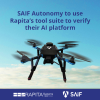 SAIF Autonomy to use RVS to verify their groundbreaking AI platform
SAIF Autonomy to use RVS to verify their groundbreaking AI platform
 RVS gets a new timing analysis engine
RVS gets a new timing analysis engine
 How to measure stack usage through stack painting with RapiTest
How to measure stack usage through stack painting with RapiTest
 What does AMACC Rev B mean for multicore certification?
What does AMACC Rev B mean for multicore certification?
 How emulation can reduce avionics verification costs: Sim68020
How emulation can reduce avionics verification costs: Sim68020
 How to achieve multicore DO-178C certification with Rapita Systems
How to achieve multicore DO-178C certification with Rapita Systems
 How to achieve DO-178C certification with Rapita Systems
How to achieve DO-178C certification with Rapita Systems
 Certifying Unmanned Aircraft Systems
Certifying Unmanned Aircraft Systems
 DO-278A Guidance: Introduction to RTCA DO-278 approval
DO-278A Guidance: Introduction to RTCA DO-278 approval
 Avionics Certification Q&A: CERT TALK (with Consunova and Visure)
Avionics Certification Q&A: CERT TALK (with Consunova and Visure)










